Hook Head, County Wexford
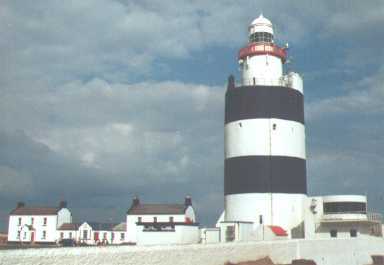 One of the oldest lighthouses in Europe, Hook Light guards the eastern entrance to Waterford Harbour (It's actually in County Wexford). In the 5th century AD, a Welsh monk, St. Dubhan, founded a monastery on the site of what is now the Old Church at Churchtown. At the tip of the peninsula, he also established a light beacon, which monks from the monastery tended for over 700 years. In the late 12th century, shortly after they first invaded Ireland, the Normans began to build the present tower on the site. The tower was later turned over to the monks, who continued to maintain the beacon on top for hundreds more years, until the 1641 Rebellion. It's not known what happened to the monks after that - presumably they were at best disbanded, at worst slaughtered by Cromwell's forces.
One of the oldest lighthouses in Europe, Hook Light guards the eastern entrance to Waterford Harbour (It's actually in County Wexford). In the 5th century AD, a Welsh monk, St. Dubhan, founded a monastery on the site of what is now the Old Church at Churchtown. At the tip of the peninsula, he also established a light beacon, which monks from the monastery tended for over 700 years. In the late 12th century, shortly after they first invaded Ireland, the Normans began to build the present tower on the site. The tower was later turned over to the monks, who continued to maintain the beacon on top for hundreds more years, until the 1641 Rebellion. It's not known what happened to the monks after that - presumably they were at best disbanded, at worst slaughtered by Cromwell's forces.
See List of Priests killed .
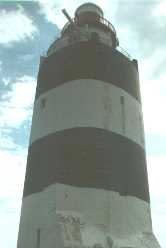
Built from local limestone, the massive original tower is 40 feet in diameter, 80 feet high, and has walls about 10 feet thick. In 1810, a narrow extension was added to the top of the original tower.
Dubhan also gave his name to the peninsula, in a roundabout way. In the 5th Century, the area was named Rinn Dubhain, which in Irish means the Headland or Point Of Dubhan. Later, Dubhan may have faded from memory, and since "dubhan" also means a fishing hook in Irish, the name was erroneously anglicised as Hook Head.
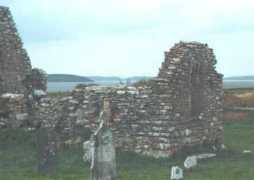
Shown left is the medieval Old Church, on the site of St. Dubhan's original monastery at Churchtown.
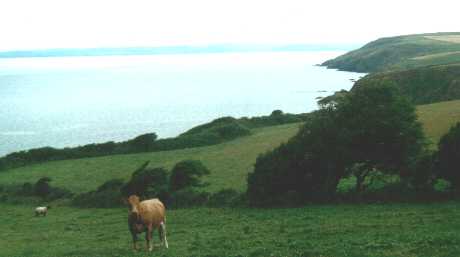
The phrase "By hook or by crook" is said to have originated in the 17th century from the geography of the area, with Oliver Cromwell's threat in 1649 that he would take Waterford City "by Hook or by Crooke" (Crooke is a small village on the Suir estuary, on the Waterford side, opposite Hook Head). Others say the phrase was in general use by sea captains, while some claim Strongbow (Richard DeClare, Earl of Pembroke) originated the phrase during the 1170 Norman invasion . Strongbow succeeded in his assault on Waterford, but Cromwell, even today the most hated man in Irish history, failed (See Duncannon Fort below).
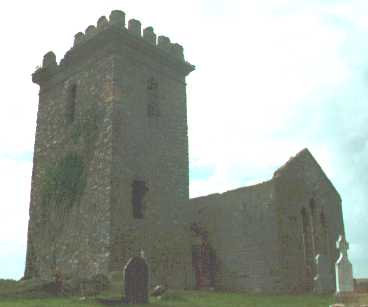 On the right is the old fortified church of the Knights Templars, with early 18th century church alongside. Parts of this site at Templetown date back to the 12th century. When the Templars property was seized by the English crown in the early 14th century, part of the goods inventory read : -
On the right is the old fortified church of the Knights Templars, with early 18th century church alongside. Parts of this site at Templetown date back to the 12th century. When the Templars property was seized by the English crown in the early 14th century, part of the goods inventory read : -
60 crannocs of wheat, price each 4s.
12 cows and 1 bull, price of each 5s.
8 horses, price of each 6s. 8d.
3 wagons, price of each 3s. 6d.
500 sheep, price of each 8d.
60 pigs at 8d each.
1 bow, price 1d.
10 silver spoons, 10d each.
A silver dish, price 20d.
2 pickaxes and 3 saws, price 1s.
One s. is one shilling, roughly 6 or 7 cents today. One d. is one twelfth of a shilling, roughly half a cent.
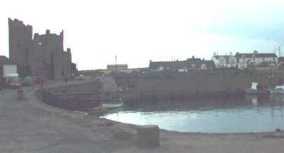
Slade Castle. Parts of the castle date back to the 16th century.

The little fishing harbour at Slade.
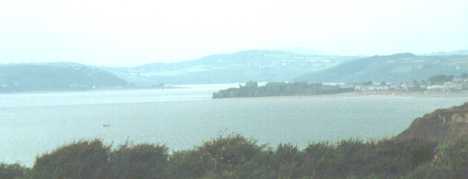 Duncannon Fort (in middle distance). Passage East can just be seen behind a narrow spit of land upriver on opposite bank. Duncannon Fort was built by the English (on the site of previous Celtic and Norman Forts) in 1586 to help repel any attack by the Spanish Armada.
Duncannon Fort (in middle distance). Passage East can just be seen behind a narrow spit of land upriver on opposite bank. Duncannon Fort was built by the English (on the site of previous Celtic and Norman Forts) in 1586 to help repel any attack by the Spanish Armada.
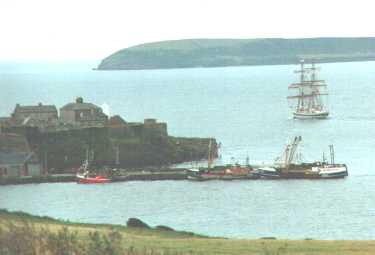 The Fort was captured by Colonel Thomas Preston of the Kilkenny Confederation in 1645. In August 1649, Oliver Cromwell and his army landed at Dublin. After the massacres by Cromwell at Drogheda and Wexford, the successful defence of Duncannon's relatively modern fort in October/November 1649 (by Colonel Edward Wogan and his troops against Ireton, Jones and Cromwell) delayed Cromwell's ships in their attempt to deploy heavy siege guns against Waterford. By the time Cromwell captured Passage Fort on the opposite bank, allowing his ships access upriver, the ground around Waterford's town walls was too wet from winter rains to support the heavy guns, and the by now reinforced town was too well defended for the unbreached walls to be stormed. So, Duncannon helped save Waterford, the only town in Ireland to sucessfully withstand an attack personally commanded by Cromwell.
The Fort was captured by Colonel Thomas Preston of the Kilkenny Confederation in 1645. In August 1649, Oliver Cromwell and his army landed at Dublin. After the massacres by Cromwell at Drogheda and Wexford, the successful defence of Duncannon's relatively modern fort in October/November 1649 (by Colonel Edward Wogan and his troops against Ireton, Jones and Cromwell) delayed Cromwell's ships in their attempt to deploy heavy siege guns against Waterford. By the time Cromwell captured Passage Fort on the opposite bank, allowing his ships access upriver, the ground around Waterford's town walls was too wet from winter rains to support the heavy guns, and the by now reinforced town was too well defended for the unbreached walls to be stormed. So, Duncannon helped save Waterford, the only town in Ireland to sucessfully withstand an attack personally commanded by Cromwell.
8 months later, however, town after town had fallen to Cromwell's forces, and Waterford had been completely cut off from all outside aid. An outbreak of plague was killing 400 of Waterford's citizens and defenders every week. Thomas Preston, now commanding Waterford, with less than 700 half-starved soldiers and townsmen left to defend the walls, had little option but to surrender, on August 10th 1650, to Ireton's army (Cromwell had left Ireland for England, his destruction of the remnants of old Gaelic Ireland almost complete). Unlike at Drogheda and Wexford, the surrender terms were generous - the garrison was allowed to march away and the citizens were not to be harmed. With Waterford and all surrounding towns lost, there was little point in Duncannon holding out, and it too surrendered, on similar terms.
Direct military action between 1641 and 1652 resulted in over 100,000 casualties. The companions of war, famine and disease brought total losses to over 600,000 from a prewar population of less than 2 million. Although as many as 1,000,000 Irish may have died during the Great Famine in 1845-1849 (from a population total of 8 million), in percentage terms the period 1641-1652 was the most destructive in Irish history.
See also Violence in Ireland
The above information is mainly from "Cromwell in Ireland" by Colonel James Scott Wheeler, Associate Professor of European History at the US Military Academy at West Point .
More background and details

Looking South from Hook Head
Next stop Spain (600 miles due South)
England (150 miles Southeast)
Central America (4500 miles Southwest)
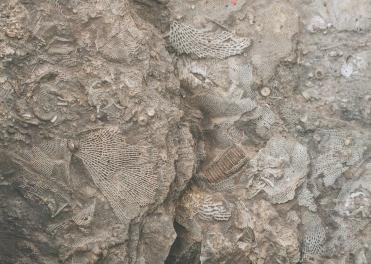
250 million year old Limestone fossils at the Hook
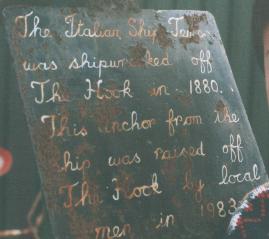
"The Italian Ship Tempo was shipwrecked off The Hook in 1880.This anchor from the Ship was raised off The Hook by local men in 1983." (Plaque in Fethard)
Richard Roche's book, "Tales of the Wexford Coast", puts the date of shipwreck at Dec 2nd 1879. In spite of Hook and other lighthouses and lightships, nearly a thousand ships were wrecked on the Wexford coast in the last few hundred years.
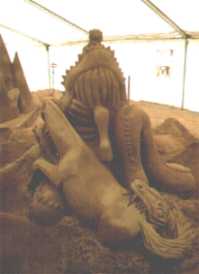
Sand Sculpture at Duncannon beach
(Held during Cockle Festival in July).
All pictures taken within 20 miles of Waterford City center.
Last updated July 26th 2000.
Most of the above information was found in tourist brochures,
or in "The Promontory of Hook", by Billy Colfer.
All images are copyright and may not
be reproduced without written permission.
If you have any enquiries, complaints or suggestions please e-mail me at earrings@eircom.net

 One of the oldest lighthouses in Europe, Hook Light guards the eastern entrance to Waterford Harbour (It's actually in County Wexford). In the 5th century AD, a Welsh monk, St. Dubhan, founded a monastery on the site of what is now the Old Church at Churchtown. At the tip of the peninsula, he also established a light beacon, which monks from the monastery tended for over 700 years. In the late 12th century, shortly after they first invaded Ireland, the Normans began to build the present tower on the site. The tower was later turned over to the monks, who continued to maintain the beacon on top for hundreds more years, until the 1641 Rebellion. It's not known what happened to the monks after that - presumably they were at best disbanded, at worst slaughtered by Cromwell's forces.
One of the oldest lighthouses in Europe, Hook Light guards the eastern entrance to Waterford Harbour (It's actually in County Wexford). In the 5th century AD, a Welsh monk, St. Dubhan, founded a monastery on the site of what is now the Old Church at Churchtown. At the tip of the peninsula, he also established a light beacon, which monks from the monastery tended for over 700 years. In the late 12th century, shortly after they first invaded Ireland, the Normans began to build the present tower on the site. The tower was later turned over to the monks, who continued to maintain the beacon on top for hundreds more years, until the 1641 Rebellion. It's not known what happened to the monks after that - presumably they were at best disbanded, at worst slaughtered by Cromwell's forces. 





 Duncannon Fort (in middle distance). Passage East can just be seen behind a narrow spit of land upriver on opposite bank. Duncannon Fort was built by the English (on the site of previous Celtic and Norman Forts) in 1586 to help repel any attack by the Spanish Armada.
Duncannon Fort (in middle distance). Passage East can just be seen behind a narrow spit of land upriver on opposite bank. Duncannon Fort was built by the English (on the site of previous Celtic and Norman Forts) in 1586 to help repel any attack by the Spanish Armada. The Fort was captured by Colonel Thomas Preston of the Kilkenny Confederation in 1645. In August 1649, Oliver Cromwell and his army landed at Dublin. After the massacres by Cromwell at Drogheda and Wexford, the successful defence of Duncannon's relatively modern fort in October/November 1649 (by Colonel Edward Wogan and his troops against Ireton, Jones and Cromwell) delayed Cromwell's ships in their attempt to deploy heavy siege guns against Waterford. By the time Cromwell captured Passage Fort on the opposite bank, allowing his ships access upriver, the ground around Waterford's town walls was too wet from winter rains to support the heavy guns, and the by now reinforced town was too well defended for the unbreached walls to be stormed. So, Duncannon helped save Waterford, the only town in Ireland to sucessfully withstand an attack personally commanded by Cromwell.
The Fort was captured by Colonel Thomas Preston of the Kilkenny Confederation in 1645. In August 1649, Oliver Cromwell and his army landed at Dublin. After the massacres by Cromwell at Drogheda and Wexford, the successful defence of Duncannon's relatively modern fort in October/November 1649 (by Colonel Edward Wogan and his troops against Ireton, Jones and Cromwell) delayed Cromwell's ships in their attempt to deploy heavy siege guns against Waterford. By the time Cromwell captured Passage Fort on the opposite bank, allowing his ships access upriver, the ground around Waterford's town walls was too wet from winter rains to support the heavy guns, and the by now reinforced town was too well defended for the unbreached walls to be stormed. So, Duncannon helped save Waterford, the only town in Ireland to sucessfully withstand an attack personally commanded by Cromwell.


